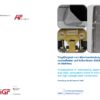Description
P 1062 – Investigations on load-bearing capacity of welded dual-steel connections made of mild carbon steel and high strength steel construction
The requirement towards slender and more filigree constructions with high loadings consistently leads to the application of high-strength steels. Decisive for the application of high-strength steels is, beside of the question of stability and fatigue, mainly the type of joints and connections. How to effectively realize the procedure of welding highstrength steels S690 to normal-strength steels S355 by fillet welds is still an open question. However, this is a standard situation existing in practice due to the fact that the choice of steel grade usually is adapted to the utilization and also because secondary components with small loadings are often added to the structure.
Design concepts in EN 1993-1-8 do not consider the strength of the weld material. In hybrid connections the weld material has to be overmatching to the high strength steel, but as strength only the mild steel strength may be taken into account.
The objective of the project is the review of the modified design resistance function or the development of a realistic and comprehensive design model for determining the carrying capacity of hybrid connections with fillet welds of normal- and high-strength steels for the utilization in steel structures and related areas (plant and crane construction). This is planned in order to improve the normative carrying capacity of fillet welds for hybrid fillet weld connections in the currently used steel standards.
Considering in future the filler metal in combination with the different base materials an appropriate choice of optimal combination of carrying capacity, toughness and deformation capacity may be achieved. In the frame of the research project component tests
are performed on one hand for the characterization of the carrying capacity and the deformation capacity of the connections, while on the other hand extensive material tests are realized for the determination of the mechanical properties. Based on the correlation between component tests and mechanical properties a detailed statistical evaluation of the results has been done.
On the basis of the evaluation of the experimental test results and the results of the statistical evaluation, the applicability of the adapted design model according to Rasche [7] was confirmed. The results will be summarized to recommendations which on one side cover the construction and welding procedure of hybrid connections for use in practice and on the other side give design rules which will be derived as a proposal for future code development for the German mirror group to be introduced into the European CEN Working Group.
Only available in german language.
Published in:
April 2019
FOSTA – Research Association for Steel Application




